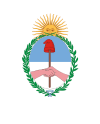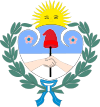Jujuy Province
| Jujuy | |||
|---|---|---|---|
| Province | |||
|
Clockwise from top: Quebrada de Humahuaca, San Salvador de Jujuy, Pucará de Tilcara, and the Hill of seven colors. | |||
| |||
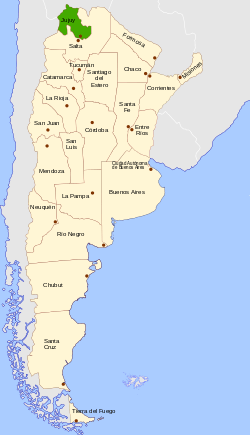 Location of Jujuy within Argentina | |||
| Country | Argentina | ||
| Capital | San Salvador de Jujuy | ||
| Departments | 16 | ||
| Municipalities and municipal commissions | 61 | ||
| Government | |||
| • Governor | Gerardo Morales (Radical Civic Union) | ||
| • Deputies | 6 | ||
| • Senators | 3 | ||
| Area Ranked 20th | |||
| • Total | 53,219 km2 (20,548 sq mi) | ||
| Population (2010[1]) | |||
| • Total | 673,307 | ||
| • Rank | 14th | ||
| • Density | 13/km2 (33/sq mi) | ||
| Demonym(s) | jujeño | ||
| Time zone | ART (UTC−3) | ||
| ISO 3166 code | AR-Y | ||
| Website |
www | ||
Jujuy (Spanish pronunciation: [xuˈxui]) is a province of Argentina, located in the extreme northwest of the country, at the borders with Chile and Bolivia. The only neighboring Argentine province is Salta to the east and south.
History
Pre-Columbian inhabitants known as the Omaguacas and Ocloyas, who were later conquered by the Incas during their expansion period, practiced agriculture and domesticated the guanaco. They had huts made of mud, and erected stone fortresses to protect their villages. An example of such fortresses is Pucará de Tilcara, Pucará meaning "fortress" (word also used for the Argentine combat aircraft Pucara).
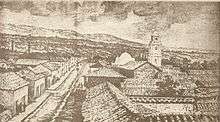
In 1593, a small settlement was erected in the Jujuy valley by the effort of Francisco de Argañaraz y Murguía. In spite of the attacks of the Calchaquíes and Omaguacas aborigines, the population and activity of the village consolidated and grew.
At the end of the 17th century, the customs to the Viceroyalty of Peru was transferred from Córdoba to Jujuy.
With the separation from Peru and the creation of the Viceroyalty of the Río de la Plata, Jujuy lost its importance and its population started to diminish.
During the May Revolution and the battles for the independence of the United provinces of the South, many confrontations took place in Jujuy because the Spanish concentrated their forces in Peru. The people of Jujuy had to endure the Jujuy Exodus, a massive evacuation with a scorched earth policy, led by General Manuel Belgrano. Finally the Spanish surrendered, but the war seriously affected the economy of the area.
After a series of internal conflicts, the province declared its autonomy from Tucumán and Salta Provinces on November 18, 1834. Jujuy started a gradual process of economic and social improvement, and at the end of the 19th century, the sugarcane industry arose. At the beginning of the following century, the railway already connected the province with Buenos Aires, and La Paz, Bolivia.
Heavy industry first arrived in Jujuy at the hand of General Manuel Savio, a presidential economic advisor who, in 1945, had Argentina's first modern steel mill installed in Jujuy. In 1969, Jujuy joined oil-rich neighboring Salta Province with the discovery of petroleum by the state-owned YPF.
Geography and climate
There are 3 main areas in Jujuy; the Altiplano, a 3,500 meters high plateau with peaks of 5,000 meters, covers most of the province. The Río Grande of Jujuy cuts through the Quebrada de Humahuaca canyon, of heights between 1,000 and 3,500 meters. To the Southeast, the sierras descends to the Gran Chaco region. The vast difference in height and climate produces desert areas such as the Salinas Grandes salt mines, and subtropical Yungas jungle.
In spite of the different areas, the terrain of the province is mainly arid and semi-desertic, except for the El Ramal valley of the San Francisco River. Temperature difference between day and night is wider in higher lands, and precipitations are scarce outside the temperate area of the San Francisco River.
The Grande River and the San Francisco River flow to the Bermejo River. The San Juan, La Quiaca, Yavi and Sansana flow to the Pilcomayo River.
Economy
Jujuy's economy is moderately underdeveloped, yet very diversified. Its 2006 economy was an estimated US$2.998 billion, or, US$4,899 per capita (over 40% below the national average).[2]
Jujuy is, despite its rural profile, not particularly agrarian. Agriculture contributes about 10% to output and the main agricultural activity is sugarcane. Its processing represents more than half of the province's gross production, and 30% of the national sugar production. The second agricultural activity is the tobacco, cultivated in the Southeaster valley, as a major national producer.
Other crops include beans, citrus and tomatoes, and other vegetables for local consumption. Cattle and goats are raised on a small scale, mainly for local dairies, and llamas, vicuñas and guanacos are raised in significant numbers for wool.
Manufacturing is more prominent in Jujuy than in some neighboring provinces, adding 15% to its economy. Jujuy is the second largest Argentine producer of iron, used by the Altos Hornos Zapla steel mill. Other industrial activities include mining for construction material, petroleum extraction at Caimancito, salt production from Salinas Grandes salt basin, and the paper production feed by the Jujuy's forests with 20% of the industrial product of the province.
The province has been served since 1967 by the Gobernador Horacio Guzmán International Airport.
Tourism
An important and still growing activity, tourism in the area brings a number of Argentine tourists (80%), tourists from other South American countries (12%) and Europeans (7%). Most tourists head for San Salvador de Jujuy to start their exploration of the province. The Horacio Guzmán international airport, 34 km from San Salvador, connects the province with Buenos Aires, Córdoba, and some destinations in Bolivia.
Apart from the fantastic contrast of land colours and formations, tourists are attracted also by the strong aboriginal roots in the culture of Jujuy. Aymará and Quechua cultures coexist in the area, and ruins of the Incas are well conserved.
Tourists who come to Jujuy visit the area of the Quebrada de Humahuaca and its Cerro de los Siete Colores, Pucará de Tilcara, Salinas Grandes and many small towns. Other less frequent destinations include the Calilegua National Park in the Yungas jungle, La Quiaca, Laguna de Pozuelos, and Laguna Guayatayoc.
Political division
The province is divided into 16 departments (in the Spanish language, departamentos).

Department (Capital):
- Cochinoca (Abra Pampa)
- El Carmen (El Carmen)
- Doctor Manuel Belgrano (San Salvador de Jujuy)
- Humahuaca (Humahuaca)
- Ledesma (Libertador General San Martín)
- Palpalá (Palpalá)
- Rinconada (Rinconada)
- San Antonio (San Antonio, Jujuy)
- San Pedro (San Pedro)
- Santa Bárbara (Palma Sola, Jujuy)
- Santa Catalina (Santa Catalina)
- Susques (Susques)
- Tilcara (Tilcara)
- Tumbaya (Tumbaya)
- Valle Grande (Valle Grande)
- Yavi (La Quiaca)
Filmed in Jujuy Province
- Veronico Cruz, (1988).
Gallery
- Ruins of the Pucará near Tilcara
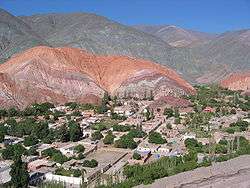 Cerro de los Siete Colores, Purmamarca
Cerro de los Siete Colores, Purmamarca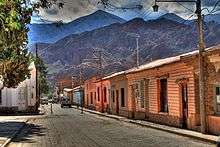 Calle de Tilcara, Jujuy, Argentina
Calle de Tilcara, Jujuy, Argentina- Patio inside the Jujuy Cathedral, San Salvador de Jujuy.
.jpg) National Route 9 between Jujuy and Salta
National Route 9 between Jujuy and Salta
See also
References
- ↑
- ↑ "El déficit consolidado de las provincias rondará los $11.500 millones este año" (in Spanish). Instituto Argentino para el Desarrollo de las Economías Regionales. Retrieved 10 July 2015.
| Wikimedia Commons has media related to Jujuy. |
External links
- Official Provincia de Jujuy website - (Spanish)
Coordinates: 23°45′S 65°30′W / 23.750°S 65.500°W

